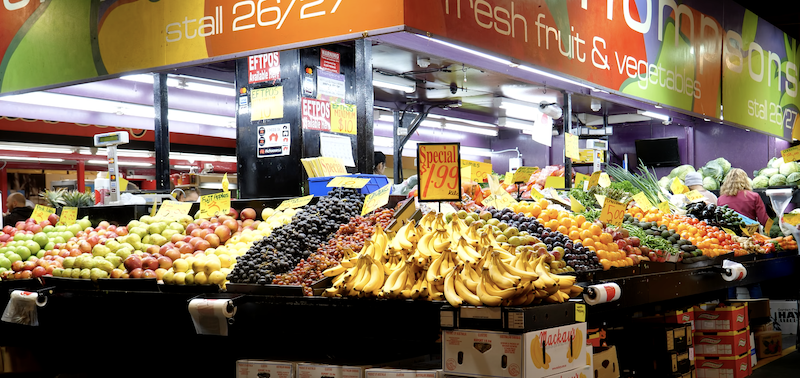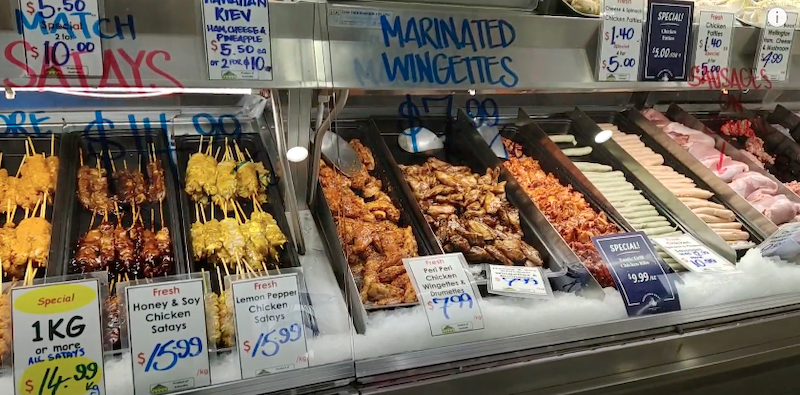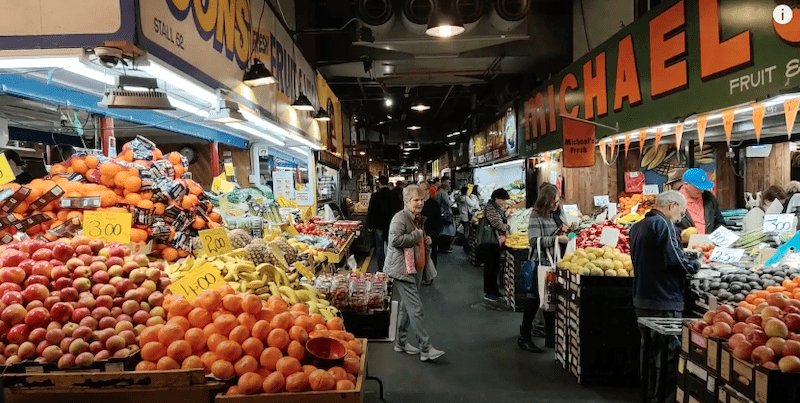To discover Adelaide Central Market to some is a journey of revelation. As it no ordinary market.
There are people who go for breakfast every Saturday morning for the ambience and vibe of a market place without every buying any market produce. Despite having the freshest produce and large variety.
There is more to this market which I cover down the post.
The State of South Australia and Adelaide City is lucky to be blessed with such iconic market which stands together with other famous markets.
Markets are everywhere and most are popular as they provide fresh essentials. They are also important as they sustain the city or town. Again commonplace. So why is it unique and an attraction? Lets start with 2 other well known markets which are major tourist draws. .
Two other famous markets
The first is Tsukiji Wholesale Fish Market in Tokyo and the second is Pike Place Market in Seattle. They are the well known in the market category for Tourism.
Tsukiji / Toyosu Fish Market
Tsukiji is the most famous. It is now known as Toyosu Fish Market having moved to the new premises in 2018. The ambience remains the same. The scale and the crazy high prices for bluefin tuna plus the intensity and speed behind the bidding by the Japanese are unmatched. We are talking seconds.
The surrounding retail and food outlets with a focus on seafood is amazing both in the new and old place. And the selection and use of knives and swords ( yes swords) to intricately slice large fish is a ritual and a performance in itself.
If you are in Japan and you have only one pass, this is it. Its one for the bucket list.
Pike Place Market
Pike Place Market on the hand is different, way different. Like any other market with the exception of the highly entertaining act of fish throwing, salmon in particular, it is much the same. It has its share of market and craft stalls and cosy eateries. It is actually small in scale.
The fish throwing however is not just a novelty, its part of the trade and gives the place a unique character. There is no reason to just work, have fun while you are at it seems to be the mantra. And why not.
Rachel the bronze cast pig of Pike Place of 1986 must have inspired our bronze cast pigs at Adelaide’s Rundle Mall. The similarity is striking. Adelaide needs to own up! Rachel too is now a must for the photo album just as our own pigs are at Rundle Mall.
Pike Place is also home to the longest standing Starbucks with the original logo. The first and original store at another location in Seattle relocated a few years later to Pike Place in 1976.
In a way Pike Place is the hub of activity on the picturesque seafront for a quiet, well spread and sparsely populated city. It’s a gathering place. Something to hold things together.
This where it is similar to Adelaide Central Market, the presence of soul.
If you go to Seattle, Pike Place Market is a must.
In the heart of the city

Firstly Adelaide Central Market is in the city centre, west of Victoria Square.
In this day and age who has a full scale functioning market with a wide range of offerings in the city centre? And in prime location.
Fresh seafood, meat, poultry, vegetables, fruits and small goods, all that you need. One wonders what happened to Von Thunen’s model and are our urban planners missing a beat?
It is actually more ominous than that. No urban planner, city or government official will suggest moving Adelaide Central Market elsewhere.
History and demographics
Adelaide Central Market is Australia’s longest running market that is 152 years old.
It is historic and the largest covered continuously operating market in the Southern Hemisphere. It began life in 1869.
The Market moves 1 million kilograms of fresh produce every month, handled by approximately 76 stalls. There are also little shops mainly cafes and eateries on three sides of the market. Plus an unexplained camera shop.
The stalls and stall holders are diverse in terms of racial identity and a reflection of Australia as a major migrant destination country.
Within this diversity in the Market, there are very clear streams of ethnic heritage of the major migrant groups.
Australians of German, Italian, Greek and Vietnamese origins are the dominant streams when it comes to stalls and stallholders.
So we are looking at a smorgasbord of offerings with influences from the old country that have adapted for the new country. But clearly Australian, if that makes sense. I will explain this better hopefully as we go along.
Last big arrivals, the Vietnamese
Each of these ethnic groups have a history. The Vietnamese are the boat people that fled after the end of the Vietnam War and their descendants .
Australia offered them a home and they grabbed it with both hands. In Adelaide they began their new life operating market gardens in the outskirts of the city and started selling at or supplying their vegetables to the Central Market.
The Governor of South Australia at the time of writing is Hieu Van Le, 67 years old, born in Vietnam and arrived by boat, landing in Darwin. We are proud of what they achieved in making Australia and Adelaide their new country and home.
If you are aware of Greeks’ affinity to seafood and what they can do with it, you won’t be surprised that Angelakis is at the top of their game. They are a well known fishmonger at Central Market and have branched out to poultry.

I might add that it is the family’s favourite stall. No longer just seafood but Thai Pandan chicken and satay sticks ready for the oven. I have also seen like other stalls, their counter staff ethnic demographics change over time as expected for Australia.
Ethnicity and migration
Sale of market produce do tend to take an ethnic line usually with first generation and sometime down to the subsequent generation. Greeks for seafood and the Vietnamese the market garden produce are examples. And the Central Market captures the story of Australian migration history and in a visual way.
However these streams will become less pronounced as stalls are bought and sold and its identity will evolve. But it will take a very long time before the migration theme is shed. Then again I could be wrong with new migration streams. We will have to wait and see.
Go see for yourself and find out why the sausage variety is wide and the influences behind it? Trace the lineage to the European continent. The same for cheese and other things. Treat it as a puzzle to solve as you walk thru the market.

Market make-up
How do you discover Adelaide Central Market without a proper breakdown of the stall types. The main categories represented are;
- Fruits and vegetables – think bright colours
- Meat, poultry and seafood – covers turkey, rabbit as well.
- Bakeries and patisseries – bread and little pleasures
- Continental and cheese – luxurious sides
- Nuts, confectionaries and coffee – take this lot seriously
- Speciality Foods – think roo meat, grains, organic, olives and the like
- Non-Food – books, flowers and that camera shop, just the three
- Cafe and eateries – try finding a seat on a Saturday, one in particular is a treasure. Let this be a surprise when you visit the Market.
The soul of the city
One of the first things I did notice over the years is the frequency of Adelaide and South Australian identities seen at the Market and I’m referring to well known identities across South Australian society. And it is not for any media attention.
Some are seen doing their market runs and others are there to meet colleagues and acquaintances. On weekends its family and friends in tow. The Market just pulls you in.
There are enough Coles, Woolies and other supermarkets and grocery stores in Adelaide without the need to go to the Central Market. It’s range of produce, freshness, atmosphere and ambience which are at another level that is the difference.
So do discover Adelaide Central Market and bring along your camera. Set it to vivid colour mode to capture the intensity of colours.
For the right atmosphere, time it for breakfast or early lunch on a Saturday. Find a seat on the inside to take in the din, the smell and the aroma of fresh coffee, and people- watching is a thing in this place.
To discover Adelaide Central Market is to discover an important slice of Australia, and not just Adelaide.
Main Pic: Courtesy of Wikipedia – https://en.wikipedia.org/wiki/Adelaide_Central_Market

Pingback: Adelaide Central Market morphs - Adelaide wide open
Pingback: South Australian Oysters - Adelaide wide open